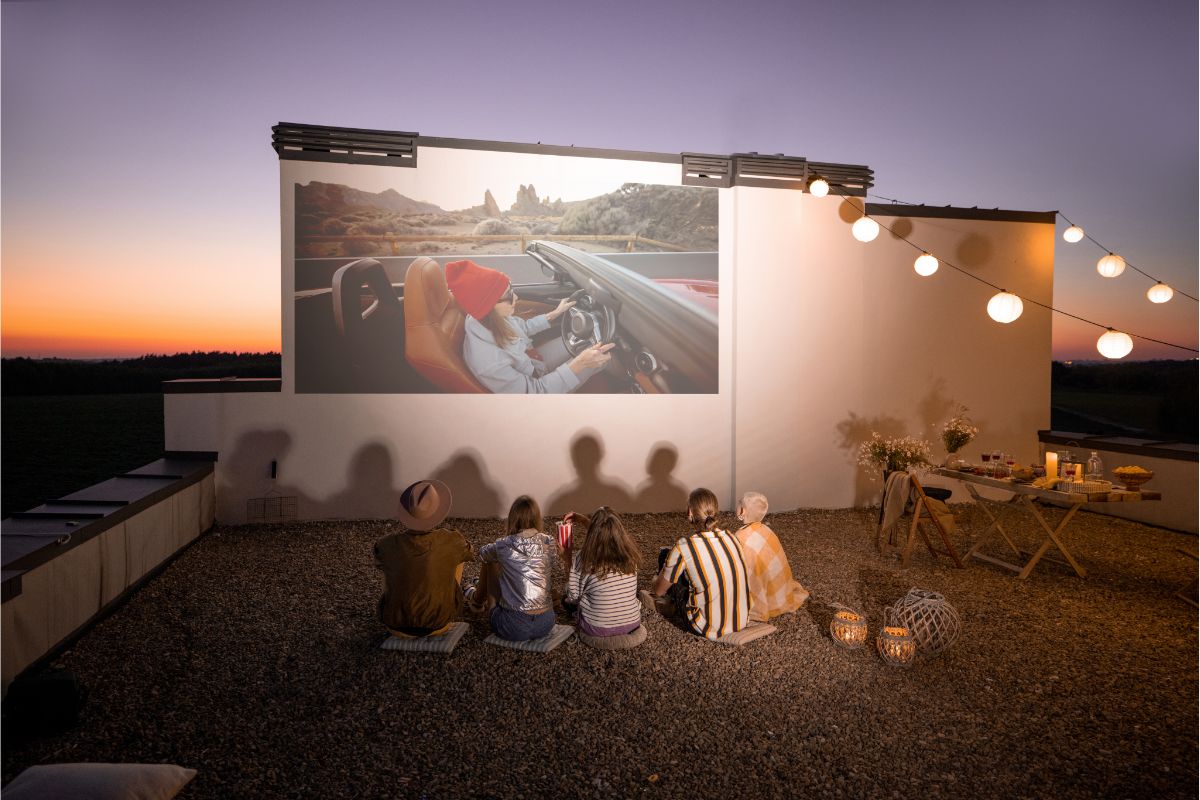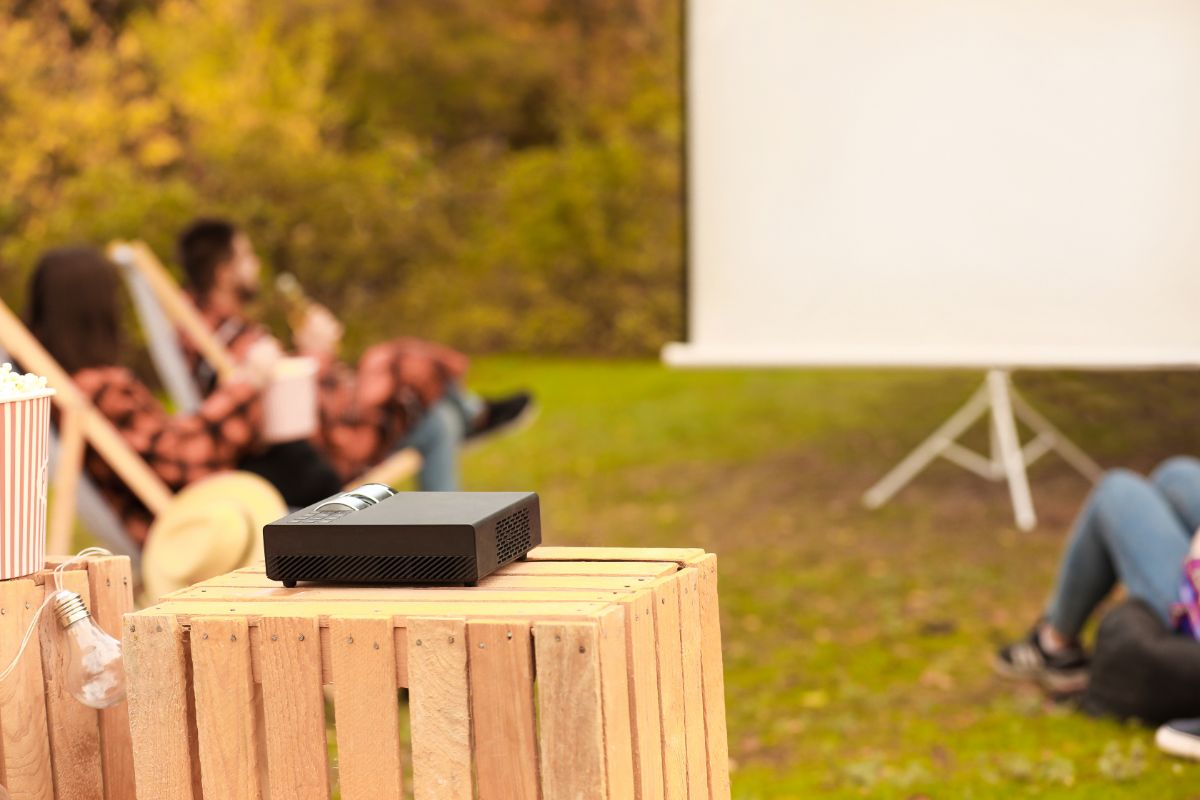Outdoor projectors are a great way to turn your backyard into your very own outdoor cinema.
However, if you’re planning on using an outdoor projector then it’s important to make sure it has enough lumens to get the job done.
If you aren’t familiar with how many lumens an outdoor projector needs, then it can be hard to know where to even start. Luckily, we’ve done all the hard work for you!
In this handy guide, we’ll take you through how many lumens your outdoor projector needs, as well as the best setup for turning your backyard into a home theater.
Contents
What Actually Is A Lumen?
Before we can take a look at how many lumens an outdoor projector needs, it’s important to understand what exactly a ‘lumen’ is in the first place.
Lumens are measurements of visible light, with higher lumens producing a brighter light than lower lumens.
A single lumen is approximately equivalent to a candle’s flame; meanwhile, a standard 60-watt light bulb will produce around 800 lumens, and an industrial floodlight can produce anywhere from 5,000 to 20,000 lumens.
In projectors, lumens play a key role not just in how bright the projected image is, but the image’s clarity and color intensity.
This is obviously very important when you’re projecting a movie or other type of film, and the number of lumens your projector produces will play a key role in the overall quality of your projection.
This is especially important for outdoor projection. When projecting at night or in the dark, you can get by with lower lumens because there is less light for the projector to contend with.
Meanwhile, you’ll need a projector with more lumens during the day as it will have to compete with natural light sources, and lower-lumen images will end up looking washed out and very difficult to see.
How Many Lumens Should An Outdoor Projector Have?
So now that we’ve taken a look at what lumens actually are, let’s take a look at how many lumens your outdoor projector will need.
Typically, outdoor projectors will range from 2,000 to 3,000 lumens, and some may even go as high as 5,000 lumens.
Around 2,000-2,500 lumens is the minimum required for outdoor projectors – this will let you get a clear and sharp image without any interference from any other light sources (such as the sun or any external lamps or light bulbs).
Any lower than this, and the image you’re projecting can become washed out and unsaturated, and lighter tones, in particular, can be harder to make out if they’re even visible at all.
If you’re looking for an outdoor projector to watch movies or something similar, then 3,000 lumens is a great baseline to aim for.
This will give you a great consistent picture quality, especially after sunset when the projector won’t have to fight against the daylight.
However, a 3,000-lumen projector can also be used during the day.
As long as it’s not especially bright, these projectors will be able to project their images without interference or issues with contrast or low sharpness.
In general, outdoor projectors work much better when it gets darker rather than during the day.
If you want to use your projector before sunset, then you’ll need a projector that has a minimum of 2,500 lumens (although a minimum of 3,000 lumens is ideal for sharp and clear images).
Otherwise, you won’t be able to use your projector to its full potential.
Similarly, the size of the screen that you’re projecting onto is also an important factor. A larger screen requires more lumens as you’ll have to position the projector further back.
If you want to maintain a sharp image with good contrast, then you need your screen to match the projector.
A 3,000-lumen projector works best for 12×7 foot or 16×9 foot projector screens, and any larger screens will need a higher-lumen projector to match.
If you’ve already gotten your projector screen, you should choose a projector to suit its size.
What’s The Best Setup For An Outdoor Projector?

Okay – so we’ve taken a look at how many lumens your outdoor projector has. But what exactly is the best setup for your outdoor projector?
The main components you’ll need for your outdoor projector are the projector itself and the surface you’ll be projecting onto.
The best surface for this is a proper projector screen – this will give you the best picture quality without affecting the color and contrast in any way.
However, you can also use a blank, flat wall instead, such as an exterior garden wall or the side of a building.
You’re better off avoiding any surface with inconsistent coloring or texturing; for example, painted walls or fence slats can affect the color and distort the projection, worsening the image you’re projecting.
As mentioned earlier, the position of your projector depends on how many lumens it has as well as the size of the screen you’re using.
If you have a larger screen, then you’ll need to position your outdoor projector further back, and it will require more lumens as a result in order to maintain a clear image.
To avoid shadows and silhouettes obscuring the screen, raise your projector up off the ground and position your seating on either side of the projector itself.
A simple camera tripod is a great way to do this.
No movie experience would be complete without a proper sound system. Luckily, using an outdoor projector makes it simple to create great sound.
Positioning some basic external speakers around your seating area will let you create an easy surround sound effect.
This is even easier to do with Bluetooth speakers, while also removing the need for a bunch of cables lying around the place.
With a bit of creativity and some practice, you can turn your outdoor projector into a great outdoor cinema in no time!
Final Thoughts
So there you have it! Now you know how many lumens you need to make the most of your outdoor projector both during the day and night, as well as the best way to set up your projector for a great outdoor cinema.
Outdoor projectors are the perfect way to turn your yard into your very own home theater – and now that you know how many lumens you’ll need from your outdoor projector, all you have to do now is try it out for yourself!
Enjoy!
